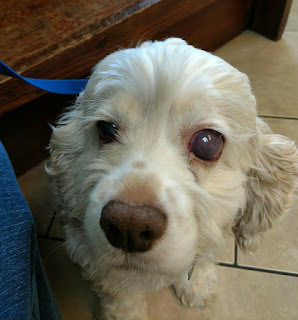 |
| Goldie before surgery |
Glaucoma is a disease we are very familiar with. At this time, we have two animals that suffered from glaucoma and another on his way.
Glaucoma is caused by severe inflammation that creates protein and other debris that blocks the tear duct. When this occurs, fluid continues to build up causing increased pressure of the eye That pressure can cause permanent damage to the optic nerve, and can result in blindness.
There are two types of glaucoma, primary and secondary. Primary glaucoma is usually genetic and occurs more often in particular breeds of both dogs and cats. It can also be caused by physical traits such as narrow angles and small pores that usually allow fluid to drain. Predisposed canine breeds include Cocker Spaniel, Poodle, Samoyed, Chow, and Siberian. Burmese and Siamese are among feline breeds prone to primary glaucoma.
 |
| Goldie post surgery |
Glaucoma can also be caused by an eye infection. This is called secondary glaucoma. It has much of the same symptoms including cloudy and red appearance, and debris may be seen in front of the eye. Head pressing may relieve headaches caused by the condition. The pet may have a behavioral change, such as avoiding play, and may not eat.
Your vet can test the pressure in the eye by using a tonometer. Normal pressure in dogs, cats is 10-20 mmHg. Increased intraocular pressure of 30 mmHg or higher are common in dogs and cats with glaucoma. It is not that unusual for them to have a pressure as high as 50 mmHg. In contrast, humans with glaucoma have pressures of 20-28 mmHg.
That is why we see such painful and shocking appearances in dogs and cats with glaucoma. Medication in the form of liquid drops can help slow the progression, but as Thomas Kern, DVM, associate professor of ophthalmology at Cornell University’s College of Veterinary Medicine, says "Once the condition occur, it is not reversible, and by the time the clinical signs of glaucoma are noticed, substantial vision loss will already have occurred.”
 |
| Chico before second surgery |
If left untreated, the pressure will continue to grow, and much like a balloon, the eye ball will continue to expand until it can take no more, collapsing and releasing the pressure. This process is extremely painful leading up to the collapse, but once the pressure is relieved, the pressure subsides.
The final treatment to relieve that pain before it reaches the point of collapse is an eye enucleation, or eye removal. As repulsive as that sounds, the dog or cat wakes up feeling so much better. You will probably notice an increase in activity, a better appetite, and all around improvement because he or she is no longer in pain.
The surgery isn't inexpensive, but it is worth every cent. If you are having difficulty affording it, try signing up for Care Credit, talking to your vet about the possibility of making payments, or do an internet search for financial help for pet parents. Start a crowdfunding fundraiser. If all else fails, you may have to give your animal up to someone who will be able to pay for the surgery. Who knows?
There may be a special needs rescue in your area.
 |
| Never treated for Glaucoma |




